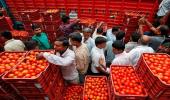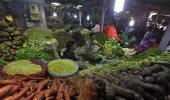Milk supplies could improve with the monsoon, provided the rains are not excessive.

Women arrive at a milk collection centre on the outskirts of Jaipur. Photograph: Anushree Fadnavis/Reuters
Mother Dairy and Amul, two of India's leading milk brands, increased their prices by Rs 2 per litre In June.
The jump, which coincided with the end of the 2024 general elections, marked the first price increase in nearly 15 months.
Days later, the Karnataka Milk Federation, selling under the Nandini brand and a significant player in the southern state, also announced a Rs 2 per litre increase.
While private milk players had increased their prices earlier, cooperatives and state-supported enterprises had managed to maintain stable prices.
Interestingly, some dairies in southern India have reduced their retail rates.
Meanwhile, in Maharashtra, milk farmers protested, demanding subsidies as procurement rates fell from Rs 30 to Rs 32 per litre last year to around Rs 28 per litre.
In response, the state government extended a Rs 5 per litre subsidy to milk producers, disbursing around Rs 224 crore (Rs 2.24 billion) to 300,000-odd farmers, according to Maharashtra Finance Minister Ajit Pawar. The remaining will be covered soon.
Amid these developments, the central government allowed the import of 10,000 tonnes of skimmed milk powder (SMP) under a tariff-rate quota system, to be managed by the National Dairy Development Board.
The quota, however, has been seldom used in the last 20 years.
The last time Amul and Mother Dairy raised milk prices was in February 2023. In the year before that, Mother Dairy had increased prices by Rs 10 per litre between March and December 2022, while Amul had hiked prices thrice in 2022.
The recent price hikes come at a time when milk supply in India, previously impacted by a Covid-induced production decline and high fodder rates, is stable.
The flush season that ended in March 2024 was one of the best in recent times. India is estimated to produce around 231 million tonnes of milk in 2022-2023, up from 221 million tonnes the previous year, with an estimated 4.5 per cent growth rate bringing 2023-24 production to around 241 to 242 million tonnes.
Cattle feed prices, a major production cost, have remained relatively stable, varying by region from Rs 23 to Rs 27 per kg. A year back, they were around Rs 23 to Rs 24 per kg.
A key question is the variance in retail price hikes among companies.

North-South divide
Traders and market players attribute this regional variance to the prices at which companies produce SMP and the stocks they hold.
Dairies either sell liquid milk, create value-added products like ghee or butter, or convert surplus into SMP for future resale.
Northern dairies, flush with SMP, are raising liquid milk prices to cover SMP production losses, while southern dairies are lowering liquid milk prices to avoid converting surplus milk into SMP.
In Maharashtra, where dairies focus on SMP and other value-added products rather than fresh liquid milk, the state government's subsidy is routed through the dairies so that milk procurement price is maintained at a reasonable level.
Roughly 10 litres of milk is needed to produce one kilogram of skimmed milk powder.
SMP prices, which were around Rs 300 per kg last year, have dropped to around Rs 210 per kg.
Companies that produced SMP at higher costs (Rs 260 to Rs 270 per kg) now face losses, leading to reduced procurement prices.
Trade estimates indicate India currently holds around 200,000 tonnes of SMP. This surplus, combined with no export opportunities, is driving down procurement prices.
"India currently has excess stock of skimmed milk powder, leading to a lack of liquidity at dairies with large amounts of costly SMP," Rahul Kumar, chief operating officer of Parag Milk Foods, told Business Standard.
Due to this surplus, dairy companies are being compelled to lower the prices at which they procure milk from farmers, and are also increasing the prices of packed milk pouches to mitigate the losses they are likely to face from selling SMP in the future, he explained.
The substantial SMP stocks, combined with a good monsoon and subsequent increase in milk production, may further depress the rates paid to farmers, which could be detrimental to milk producers, Kumar emphasised.
He suggested government assistance through export subsidies for SMP to reduce surplus stocks and ensure fair prices for farmers.
The monsoon factor
Industry players noted that milk supplies could improve with the monsoon, provided the rains are not excessive.
"Too much rain can harm milk supplies, but a drizzle is good for milk production," said Bhupendra Suri, CEO of Godrej Jersey, a private dairy player in southern India that makes Creamline Dairy Products.
Dairy animals, he added, are at higher risk of exposure to viruses, bacteria, and infections during monsoon, leading to reduced intake of feed. Grazing areas, too, shrink during the rains, and as the focus of farmers shifts to agriculture, animal care is neglected.
Vaccination, especially for diseases like foot and mouth, and deworming are crucial ahead of the rains, Suri said.
As a long-term solution, experts recommend boosting India's annual milk production rate, which has stagnated recently.
While earlier projections aimed for 300 million tonnes by 2028 with 7 to 8 per cent annual growth, recent growth has been a more moderate 4 to 5 per cent per year.
Rising fodder rates and halted exports have led to excess milk and price volatility, impacting farmers' earnings and investment in cattle, further reducing supplies.
Global SMP prices, now around Rs 231 per kg, are lower than the cost of production for many Indian dairies (which is around Rs 260 to Rs 270). This pricing makes Indian milk less competitive globally.
This is, however, not a sign that India's milk demand won't grow.
With rising incomes and growing per capita consumption, a NITI Aayog report projects that under a 'Business As Usual' approach, India's milk demand will be around 480 million tonnes by 2047 to 2048.
The 'Business As Usual' scenario is one where current economic growth (6.34 per cent) continues into the future.
In the event of high-yield growth, the demand is projected to touch 527 to 606 million tonnes by that year.
Meanwhile, the consumer, already bearing the brunt of high food prices for the last one year, now has another reason, in milk, to tighten the purse strings.
Feature Presentation: Ashish Narsale/Rediff.com











 © 2025
© 2025